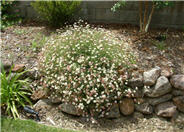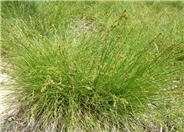
Common name:Valley Oak, Calif. White Oak, Roble
Botanical name:Quercus lobata
The Valley Oak is a large deciduous tree that grows 60'-80' tall. It develops a rounded canopy that spreads 50'-70' wide with leaves deeply lobed, rounded and gray green. This is the fastest growing of the oaks, with low watering needs. It is a CA native and attracts squirrels and birds who love the acorns.

Common name:Mission or Tree Cactus, Indian Fig
Botanical name:Opuntia ficus-indica
This unusual looking cactus forms a trunk topped with pads (actually the leaves) that have few spines. Flowers are yellow to orange in late spring and early summer, found at the edges of the pads. Green edible fruit follows the bloom period. Fruit turns purple when ripe. This cactus need full sun and well draining soil; it will reach 12'-15' tall. It is frost sensitive. The newly formed pads, or nopales of this cactus are used to make a delicious salsa.

Common name:Beaked Yucca
Botanical name:Yucca rostrata
Yucca rostrata is a slow growing succulent, growing 10'-12', that is tree-like when mature. It has stiff, blue, 2' long leaves with yellow margins. It forms a tall narrow trunk. A spectacular summer display of creamy white flowers on an orange stalk rise above the foliage on mature plants. It prefers full sun or very light shade and rocky, well drained, alkaline soil. Be careful not to plant near walkways as foliage has sharp tips. It is drought tolerant once it's established.

Common name:Santa Barbara or Mexican Daisy
Botanical name:Erigeron karvinskianus
This low mounding perennial, with fine leaves and white to pinkish daisy-like flowers, is an excellent asset to rock gardens.

Common name:Common Field or Slender Sedge
Botanical name:Carex praegracilis
This California native grass can tolerate occasional flooding or standing water as it is found in marshes and wetlands. It does make a great lawn substitute as it can be mowed, will take sun and part sun and need watering once a week in hot summer months. This sedge uses much less water than sod. It can be used for erosion control also.
| Designer: Christian Kiillkkaa | Looking Back to the Patio |
Photographer: GardenSoft |
Soils and Compost:
Incorporate compost 6" into your soil to retain water, reduce compaction, feed earthworms, and provide valuable nutrients to your plants.
Water Saving Tip:
Apply a layer of mulch around plants to reduce moisture loss.
Choose organic mulches, such as shredded bark, compost or aged sawdust.
Integrated Pest Management:
Drip and other smart irrigation delivers water directly to roots, allowing no excess water for weeds.
